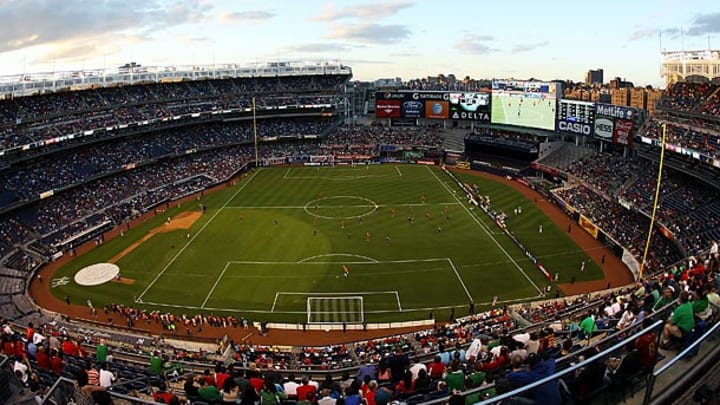MLB fields coordinator: NYCFC, Yankees sharing Yankee Stadium not ideal, but doable

Yankee Stadium has hosted a few soccer matches, including a friendly between Spain and the Republic of Ireland in 2013. (Mike Stobe/Getty Images)

Sharing is never easy, especially when it comes to Yankee Stadium and the needs of both a Major League Baseball and a Major League Soccer team. And while having both teams use the venue as their home is not ideal, Murray Cook, MLB’s fields and facilities coordinator, tells SI.com "it is doable."
The New York Times reported Monday night that New York City FC will play its first three MLS seasons, starting in 2015, in Yankee Stadium, with the official announcement expected next week. With Manchester City FC and the Yankees teaming up to bring MLS to New York City, Yankee Stadium was the logical business choice for a stopgap home.
But logistics have to work on the field too.
“Is it ideal?” Cook ponders. “It is not the greatest, but it works. It is doable.”
MLB and MLS seasons run concurrently, meaning stadium crews must handle 81 baseball games and at least 17 soccer games each year. We’ve already seen a taste of what soccer looks like on the Yankee Stadium grass, with the 50,000-seat venue hosting four games in the last two years and another game planned for July 30 when Manchester City plays Liverpool. Without a designated width for a soccer field — just parameters to fall within — Yankee Stadium’s baseball-first design forces a narrower pitch than typically seen. It also requires temporary grass every time soccer is played.
With the field running from the left field wall toward the first base line foul territory, sod must cover the vast majority of infield clay. Cook says laying ready-play sod has turned commonplace.
“You literally lay it down and that day you can play on it,” he says.
Two MLB and MLS teams streamlined that practice already when the Washington Nationals and D.C. United shared RFK Stadium nearly a decade ago.
Larry DiVito, currently the head groundskeeper at Target Field for the Twins, was in charge of the turf in D.C. during the shared years. He tells SI.com that changing from baseball to soccer comes easy with “good quality thick-cut sod.” But switching back gets challenging.
“The dirt/turf edges on baselines and infield need to be excavated for soccer and then backfilled to grade again for baseball,” he says. “This takes time and can't be done in the rain, unless you have an inflatable tarp you can work underneath.”
On top of that, the fresh sod for soccer requires rolling it in for playability, compacting the dirt underneath and making it difficult to get the infield back up to baseball conditions, especially during a tight turnaround.
“Simply put, you are not going to be able to keep both the soccer and baseball players and coaches completely happy when both sports are going on for six to seven months,” DiVito says. “Tough challenges ahead in New York City.”
Cook recalls the D.C. stadium sharing experiment, saying it was a "trial and error" process.
“I remember going in for a soccer game and the next day they played baseball there,” Cook says. “In D.C. they had (the transition) down to overnight. It took trial and error.”
If NYCFC lasts the reported three seasons at Yankee Stadium, expect plenty of time for trial and error. Joining up temporary grass with the permanent outfield grass requires crews to “cut in the edges and bevel those areas so you don’t have an abrupt change.” In the Bronx, that should be an easier situation than other places. “Yankee Stadium is pretty flat,” Cook says. “Soccer guys are wanting it pretty consistent.”
And while picking up and laying down temporary sod — while connecting it to the permanent sod — proves a tricky transition, crews will also need to take extra precaution to keep it dry.
“You can’t go take out three to four inches of infield clay, so you are not going to get the drainage,” Cook says of the turf over top the infield. “You have to be more cognizant of rain and cover that.”
There’s one more little issue in the infield: the pitcher’s mound. Rising 10 inches above the rest of the field, some stadiums — such as RFK when the Nationals and United shared — feature a retractable mound. Yankee Stadium doesn’t have that, and Cook says the team will need to rebuild something that works.
“We’ve worked in parks where they build the entire mound on a steel plate and bring it out and set it in,” he says of possible solutions in New York.
If crews can get the infield figured out, what about the extra stress on the outfield turf? “When you talk about the wear and tear of the turf you have to incorporate some aggressive maintenance,” Cook says. “In Oakland they play football and are still able to play baseball. Soccer is not as aggressive on a field as football.”
Of course, at least 17 extra games will require a beefed up dose of aggressive turf maintenance. As Cook says, though, a doable scenario. Just not ideal.
Tim Newcomb covers stadiums, design and gear for Sports Illustrated. Follow him on Twitter at @tdnewcomb.
